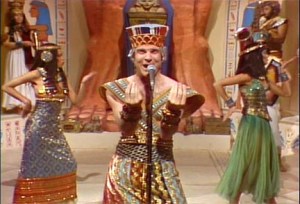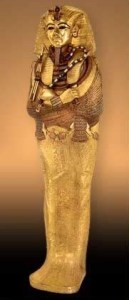If I asked random people on the street to name a pharaoh, most would say King Tut. (More than a few would probably also look at me oddly.) They wouldn’t even call him a pharaoh (much less by his full name, Tutankhamen), because we’re so used to the phrase “King Tut.”
Why My Students Think Tut Is So Damn Famous
Every semester, I ask my students why Tut is so gosh darn famous. A few mention he was the boy-king, which is a true fact: he ruled from approximately the age of 9 to 19. But that’s not why he’s famous. Child rulers periodically happen in monarchies. They’re universally terrible. Powerful court officials and family members never fail to step in and “guide” young kings. Kings are known for their actions, and child kings don’t have them.
You probably can’t actually name a child ruler, and if you can, it’s because they grew up into a capable adult king.
Some students mention he may have been murdered. We did have that suspicion for a long time, due to a crack in his skull. However, with better imaging equipment, we now know the crack was caused post-mortem, probably when the priests were removing his brain via his nose, or possibly when the body was removed from the tomb in the 20th century.
Kings periodically get murdered. You haven’t heard of most of them either.
The most recent studies suggest Tut very non-dramatically died of malaria.
One day, a student in the back piped up: “Steeeve Martin!”
Which was actually quite an interesting point. How many people know of Tut through Steve Martin, rather than through the reason Martin sang about him to begin with? And, yes, in the 1970s Steve Martin sang a song about King Tut that was a top-40 hit.

So, to rephrase: “Why is Tut so famous Steve Martin created a top-40 song about him?”

Losing and Finding the Not Quite Untouched Tomb
Many students do know that Tut is primarily famous for the treasures found in his tomb. (Many of those treasures were on tour in the 1970s, which is specifically what motivated Martin’s song.) Most, however, believe the tomb was never touched until the 20th century when Howard Carter found it.
Which is absolutely not true.
Someone had already ransacked the outer chamber. Small, portable items were missing, as if the thief grabbed the easy stuff and ran.
But the rooms beyond were intact, including the burial chamber: four nested gold-gilt wood boxes containing a granite sarcophagus, containing a gold-gilt wood coffin, containing a wood coffin decorated in gold wire mesh and enamel, containing a solid gold coffin, containing a mummy in a solid gold death mask.
All for a nineteen year old boy who accomplished very little in his life.
Ironically, the reason Tut’s tomb was mostly not robbed is that the ancient guardians (who were also frequently the robbers) forgot where it was. When Ramesses VI had his tomb dug nearby, the debris buried the entrance to Tut’s.Tut’s treasures were protected by bureaucratic error, but only after at least one thief managed to get inside.
Psusennes I
Tut comes from the New Kingdom time period. The period of decline afterward is the Third Intermediate Period. Intermediate pharaohs are not well known, and Egypt was less prosperous and more divided in these times.
Psusennes I comes from this period. While his tomb was not as rich as Tut’s, Psusennes did still have a solid gold death mask and a well-crafted, solid silver coffin. “Less prosperous” is a fairly relative phrase in Egyptian history.
Silver Coffins
Psusennes does have a somewhat less impressive coffin: it’s merely solid silver rather than solid gold. However, the skill involved is still evidence of a great amount of wealth. There also may have been religious motivations behind the choice of silver: gods were thought to have bones of silver and skin of gold. Psusennes suffered from weak bones, so the silver coffin might have been an attempt to make him whole as he returned to the gods.
Later pharaohs can offer no such excuses. Here, Psusennes is on the left, and later pharaoh Sheshonq II on the right. (click for full images)
I can’t help but feel sorry for Sheshonq II, who ruled more than 100 years after Psusennes and clearly suffered a declining economy. Who wants to show up to the afterlife in that?
Why So Unknown?
So why the hell has no one ever heard of Psusennes I? Because he was found in 1940.
Not only did people have bigger issues on their mind, but the finder, French Egyptologist Pierre Montet, had to do the archeological equivalent of pack on the fly, hurriedly tossing his finds in boxes because the Axis forces were invading Egypt.
Just one more thing you can thank Hitler for. Without the Second World War, Psusennes could have been a very big deal.



